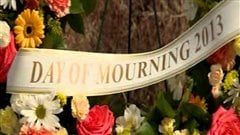Ceremonies were held in cities across Canada yesterday to commemorate workers who have died of injuries suffered on the job.
The Canadian Labour Congress estimates four people die every day in Canada from work related injuries. In the province of New Brunswick last year, 12-thousand people were injured at work, and eleven died of their injuries.
In Nova Scotia, eleven people have died so far this year, including five fishermen who drowned when their boat overturned in the ocean in February

Yesterday in the western province of Alberta, roughly 100 people gathered outside a memorial garden at the Alberta Construction Safety Association in Calgary. They were there to remember those who have died from injuries or diseases acquired through their jobs. Last year, 145 Albertans died from workplace injuries.
“It’s a pretty serious problem,” says Mike Street, co-chair of the Day of Mourning committee. “Every one and a half days, someone loses their life at work.”
In the national capital Ottawa, flags on city hall and on the Peace Tower of the Parliament buildings were lowered to half staff.
“The Day of Mourning is about more than remembering the dead. It’s also about fighting for the living and making our workplaces safer and healthier,” said Paul Moist, national president of the Canadian Union of Public Employees.
The day of mourning has been held in Canada since 1984 when it was begun by the Canadian Union of Public Employees and endorsed the following year on a national level by the Canadian Labour Congress as the Workers Memorial Day. In 1990 the Workers Mourning Day Act was passed marking April 28 1991 as the National Day of Mourning for workers killed or injured, officially becoming Workers Mourning Day.
The concept has now spread to 80 other countries worldwide.







For reasons beyond our control, and for an undetermined period of time, our comment section is now closed. However, our social networks remain open to your contributions.